
\[1,2\;\]di-bromocyclohexane on dehydrohalogenation gives
A. 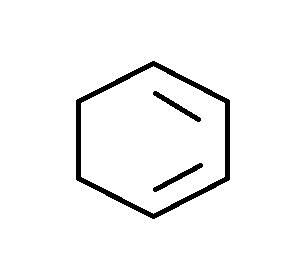
B. 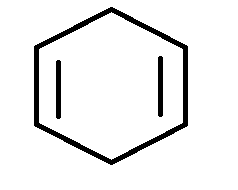
C. 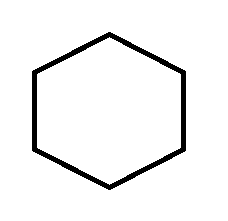
D. 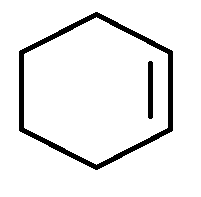
Answer
221.4k+ views
Hint: \[1,2\;\]di-bromocyclohexane has the following structure
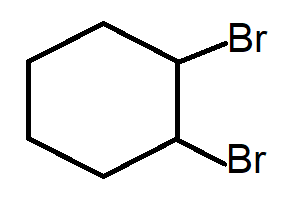
Dehydrohalogenation is a chemical reaction that undergoes removal of halogen and hydrogen to form alkene. ‘de’ means removal, ‘hydro’ means hydrogen, ‘halogen’ means halogen. The halogen and hydrogen must be present on adjacent positions.
Complete step-by-step answer:Dehydrohalogenation takes place in presence of a strong base like $KOH$. The $O{H^ - }$ accepts a hydrogen from the adjacent position of a good leaving group resulting in formation of positive charge which converts into a double bond by removal of the leaving group, namely halide for this particular reaction. In reality, the positive charge is actually not formed because the entire process occurs in a concerted manner. It is only to understand the basic mechanism. The elimination follows $E2$ mechanism which is a one step process with no intermediate (or positive charge) but only proceeds through the transition state. In \[1,2\;\] di-bromocyclohexane , the two bromides are present at \[1,2\;\] positions on cyclohexane. Each bromide will leave along with adjacent hydrogen to form a product similar to option A.
Hence A is the correct answer.
Option ‘A’ is correct
Additional Information: Alkene formation can follow Saytzeff elimination (more substituted alkene) or Hofmann elimination (less substituted alkene). Saytzeff elimination is followed in case of neutral molecules and Hofmann in case of charged species.
Note: Dehydrohalogenation requires proper stereo or proper orientation of the atoms. To undergo elimination, halogen and hydrogen must be anti-planner to each other. Hence, dehydrohalogenation is a stereospecific reaction. Dehalogenation reaction is also a type of reaction which eliminates two halogens present at \[1,2\;\]. But it is carried out only in presence of reagents like zinc dust,$NaI$, $MeOH$OR $EtOH$.

Dehydrohalogenation is a chemical reaction that undergoes removal of halogen and hydrogen to form alkene. ‘de’ means removal, ‘hydro’ means hydrogen, ‘halogen’ means halogen. The halogen and hydrogen must be present on adjacent positions.
Complete step-by-step answer:Dehydrohalogenation takes place in presence of a strong base like $KOH$. The $O{H^ - }$ accepts a hydrogen from the adjacent position of a good leaving group resulting in formation of positive charge which converts into a double bond by removal of the leaving group, namely halide for this particular reaction. In reality, the positive charge is actually not formed because the entire process occurs in a concerted manner. It is only to understand the basic mechanism. The elimination follows $E2$ mechanism which is a one step process with no intermediate (or positive charge) but only proceeds through the transition state. In \[1,2\;\] di-bromocyclohexane , the two bromides are present at \[1,2\;\] positions on cyclohexane. Each bromide will leave along with adjacent hydrogen to form a product similar to option A.
Hence A is the correct answer.
Option ‘A’ is correct
Additional Information: Alkene formation can follow Saytzeff elimination (more substituted alkene) or Hofmann elimination (less substituted alkene). Saytzeff elimination is followed in case of neutral molecules and Hofmann in case of charged species.
Note: Dehydrohalogenation requires proper stereo or proper orientation of the atoms. To undergo elimination, halogen and hydrogen must be anti-planner to each other. Hence, dehydrohalogenation is a stereospecific reaction. Dehalogenation reaction is also a type of reaction which eliminates two halogens present at \[1,2\;\]. But it is carried out only in presence of reagents like zinc dust,$NaI$, $MeOH$OR $EtOH$.
Recently Updated Pages
Is PPh3 a strong ligand class 12 chemistry JEE_Main

JEE Main 2025-26 Mock Test: Organic Compounds Containing Nitrogen

JEE Main 2025-26 Organic Compounds Containing Nitrogen Mock Test

Full name of DDT is A 111trichloro22bispchlorophenyl class 12 chemistry JEE_Main

JEE Main Mock Test 2025-26: Purification & Characterisation of Organic Compounds

JEE Main Chemical Kinetics Mock Test 2025-26: Free Practice Online

Trending doubts
JEE Main 2026: Application Form Open, Exam Dates, Syllabus, Eligibility & Question Papers

Derivation of Equation of Trajectory Explained for Students

Hybridisation in Chemistry – Concept, Types & Applications

Understanding the Angle of Deviation in a Prism

How to Convert a Galvanometer into an Ammeter or Voltmeter

Degree of Dissociation: Meaning, Formula, Calculation & Uses

Other Pages
Solutions Class 12 Chemistry Chapter 1 CBSE Notes - 2025-26

NCERT Solutions For Class 12 Chemistry Chapter 1 Solutions - 2025-26

The D and F Block Elements Class 12 Chemistry Chapter 4 CBSE Notes - 2025-26

NCERT Solutions for Class 12 Chemistry Chapter Chapter 7 Alcohol Phenol and Ether

NCERT Solutions ForClass 12 Chemistry Chapter Chapter 8 Aldehydes Ketones And Carboxylic Acids

JEE Advanced Marks vs Ranks 2025: Understanding Category-wise Qualifying Marks and Previous Year Cut-offs




